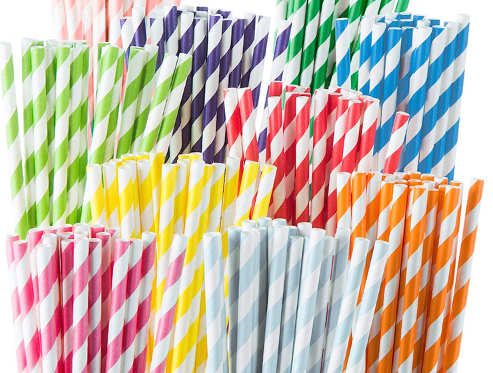Definition of Paper Straw and PLA Straw
Paper straw and
PLA straw are both eco-friendly alternatives to traditional plastic straws.
 A. Paper Straw
A. Paper Straw
A
paper straw, fashioned from biodegradable materials such as paper or cardboard, is intended for single use before being disposed of, causing no harm to the environment. To enhance their durability and water-resistance,
paper straws are frequently coated with a thin layer of wax or plant-based substances. They have gained popularity among conscientious individuals and businesses seeking to curtail their plastic waste.
 B. PLA Straw
B. PLA Straw
A PLA (polylactic acid) straw, contrived from a biodegradable and compostable material obtained from renewable resources like cornstarch or sugarcane, bears resemblance to plastic straws in both appearance and functionality. However, its environmental impact is significantly reduced. Over time,
PLA straws decompose naturally, diminishing the volume of plastic waste that accumulates in landfills or pollutes the oceans. Food service establishments often employ
PLA straws, viewing them as a more sustainable alternative to traditional plastic straws.
Composition and Manufacturing Process
When it comes to
paper straws, the materials used typically include paper and a food-grade adhesive. The manufacturing process involves cutting the paper into thin strips, which are then rolled tightly around a metal or plastic rod. The adhesive is applied to secure the layers together, and the rod is removed to create the hollow center of the straw. This delicate process requires skilled hands and precision to ensure the final product is sturdy and functional.
In contrast,
PLA straws are made from a biodegradable material called polylactic acid (PLA), which is derived from renewable resources such as cornstarch or sugarcane. The manufacturing process for
PLA straws is a bit more complex. First, the PLA pellets are carefully melted to a specific temperature, ensuring the material reaches the ideal consistency. The melted PLA is then extruded into long, thin tubes, resembling the shape of a traditional straw. These tubes are carefully cut to the desired length, resulting in the creation of
PLA straws.
While both
paper straws and
PLA straws serve the purpose of providing a sustainable alternative to plastic straws, their composition and manufacturing processes differ significantly.
Paper straws require the use of adhesive and precise rolling techniques, while
PLA straws involve the melting and extrusion of PLA pellets. These differences not only impact the materials used but also the overall durability and functionality of the straws.
Common Questions:
1.What is the shelf life of PLA straws?
PLA straws generally have a shelf life of 12 months under reasonable storage. It will not biodegrade during storage, and it deteriorates because the product may become brittle or discolored during storage.
2.Why don't paper straws get soggy?
Since 100% paper would result in a straw too soaked to sip from, most of them have a coating of polyethylene (PE) or acrylic resin, the same materials used for making plastic bags and adhesives.
Environmental Impact
 Paper Straw
Paper Straw
One of the key advantages of
paper straws is their biodegradability. Unlike plastic straws that can take hundreds of years to break down,
paper straws can decompose within a few months, reducing their impact on the environment. Made from sustainable materials such as bamboo or paper derived from responsibly managed forests,
paper straws are a more eco-friendly alternative to plastic.
When disposed of in landfills,
paper straws have a relatively low impact compared to plastic straws. Since they are biodegradable, they will eventually break down and decompose, minimizing their contribution to landfill waste.
PLA Straw
PLA (polylactic acid) straws, often referred to as bioplastic straws, are also biodegradable. They are made from plant-based materials such as cornstarch or sugarcane, which can be broken down by natural processes, reducing their environmental footprint. Similar to
paper straws,
PLA straws help reduce the reliance on fossil fuels and contribute to a more sustainable production cycle.
When disposed of in landfills,
PLA straws have a minimal impact on the environment. As they are biodegradable, they will eventually degrade and return to the natural ecosystem, reducing the accumulation of plastic waste in landfills.
Hyde has 12 years of export experience and has exported to more than 150 countries, if there is a certain kind of straw in your heart, you can feel free to contact us to custom and wholesale, we will reply within 24 hours.
 4018
4018 351
351


 The Diversity of Corrugated Boxes Packaging
The Diversity of Corrugated Boxes Packaging
 Health Concerns With Disposable Paper Plate Usage
Health Concerns With Disposable Paper Plate Usage
 Understanding PE Coated Paper
Understanding PE Coated Paper
 Versatile Bamboo Sticks: Types, Uses, and Benefits
Versatile Bamboo Sticks: Types, Uses, and Benefits